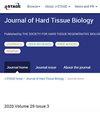Autograft of Demineralized Dentin Matrix Prepared Immediately after Extraction for Horizontal Bone Augmentation of the Anterior Atrophic Maxilla: A First Case of Non-Vital Tooth-Derived Dentin
IF 0.4
4区 医学
Q4 ENGINEERING, BIOMEDICAL
引用次数: 5
Abstract
: Onlay bone augmentation is a challenging field, especially in esthetic zones. In implant dentistry, labial bone loss is generally recovered through autologous bone and/or biomaterials. Dental pioneers have been applying a patient-own demineralized dentin matrix (DDM) for bone regeneration. The aim of this study was to histologically and radiologically evaluate horizontal bone augmentation on an anterior atrophic maxilla using an autograft of non-vital tooth-derived DDM for implant. A 56-year-old female patient presented with severe labial bone loss. Autologous DDM was immediately pre pared for horizontal ridge augmentation. DDM blocks were fixed with titanium screws for lateral augmentation. DDM gran ules were grafted on the atrophic bone between the DDM blocks. Twelve months postoperatively, bone biopsy was per formed from the implant placement point for histological observation. X-ray computed tomography (CT) was performed before and after the DDM graft surgery. Hematoxylin and eosin sections showed that new bones were directly generated on the DDM residue. CT images showed the original buccal bone lines and root-type and wall-type DDM. The grafted DDMs were clearly found on the original bone. The outlines in the 22nd region indicated an 8.11 mm horizontal width after the implant placements compared to 4.95 mm before the augmentation. Additionally, the width at the upper level increased from 3.38 mm to 5.92 mm. DDM scaffolds contributed to the horizontal bony support required to place the implants. The patient experienced therapeutic success with DDM immediate autograft and implant surgery.拔牙后即刻制备的脱矿牙本质基质自体移植物用于前萎缩上颌骨水平骨增强:一例非生命牙源性牙本质
隆骨术是一个具有挑战性的领域,尤其是在美学领域。在种植牙科中,唇骨丢失通常通过自体骨和/或生物材料修复。牙科先驱一直在应用患者自己的脱矿牙本质基质(DDM)进行骨再生。本研究的目的是通过组织学和放射学评估使用非重要牙源性DDM自体移植物进行种植的前萎缩上颌水平骨增强。56岁女性患者表现为严重的唇骨丢失。立即制备自体DDM用于水平嵴增强。用钛螺钉固定DDM块进行外侧增强。在DDM块之间将DDM颗粒移植到萎缩骨上。术后12个月,在种植体放置点行骨活检观察组织学。在DDM移植手术前后分别行x线计算机断层扫描(CT)。苏木精切片和伊红切片显示,DDM残基上直接生成了新骨。CT显示颊骨线原形,根型和壁型DDM。移植的ddm在原骨上清晰可见。第22区域的轮廓显示种植体放置后的水平宽度为8.11 mm,而增加前为4.95 mm。上层宽度由3.38 mm增加到5.92 mm。DDM支架有助于放置植入物所需的水平骨支撑。患者通过DDM即刻自体移植物和种植手术获得治疗成功。
本文章由计算机程序翻译,如有差异,请以英文原文为准。
求助全文
约1分钟内获得全文
求助全文
来源期刊

Journal of Hard Tissue Biology
ENGINEERING, BIOMEDICAL-
CiteScore
0.90
自引率
0.00%
发文量
28
审稿时长
6-12 weeks
期刊介绍:
Information not localized
 求助内容:
求助内容: 应助结果提醒方式:
应助结果提醒方式:


